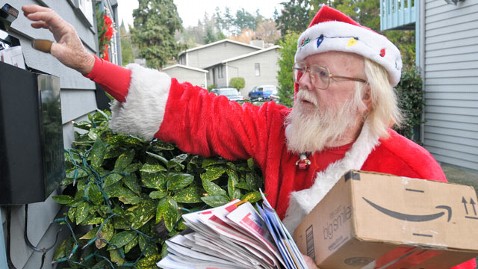As I write this post, I am also prepping my Christmas cards for the year.
I have sent out Christmas cards for probably about 10 years now. They’re usually paper cards, but I did send electronic cards once or twice as a nod toward saving paper and being more environmentally friendly. Now, while going paperless may seem to be the best option from a sustainability standpoint (including my husband’s suggestion of “just not sending any”), I will admit a strong bias to continuing traditional practices like mailing an annual Christmas card. The real goal of this tradition is to keep in touch with those who are far away, and while I was able to do that with electronic cards, I didn’t experience the warm, fuzzy feeling of actually stamping and mailing envelopes during the holidays.
Interestingly enough, in the times of endless screen time and electronic communication, there still appears to be a push for paper greeting cards. According to some sources, Millennials (the group associated with the decline of many and sundry industries, from diamonds to paper napkins) are not killing greeting cards, but rather seem to feel that a physical card sets aside important holiday interactions from daily electronic-based communications. In fact, bespoke, hand-crafted cards are growing in popularity for special occasions.[1]
Christmas SWAG (Scientific Wild-Ass Guess)
So what is the impact of these paper greeting cards over the electronic alternative? The numbers in this area are not incredibly forthcoming, but it is safe to say that a large number of people are employed by the various industries related to tree farming, paper production, greeting card generation, and mail delivery in general, and those industries are bolstered by the sheer volume of holiday cards sent every year. For example, “sales of greeting cards have been fairly stable in the U.S. over the past five or six years, with consumers buying around 6.5 billion greeting cards and 1.6 billion holiday cards per year, said Peter Doherty, executive director of the Greeting Card Association. Those figures don’t include custom photo cards, the kind many families order from places like Shutterfly or Walgreens.”[2]
According to one source, 2 billion Christmas cards are sent in the US every year.[3] It is not clear whether that number includes hand-made cards (like I used to have time to do, somehow) or custom-ordered cards from online services such as Snapfish (like I do now), but as the Chicago Tribune quoted 1.6 billion standard greeting cards alone, let’s assume we’re looking at something on the order of 2 billion holiday cards sent per year.

Your average greeting card weighs about 30 grams, just over 1 ounce,[4] requiring a minimum of 134 million pounds of paper. According to the Sierra Club, it takes about 8 trees to produce 1,000-2,000 pounds of paper.[5] For the sake of ease, we’ll say 1,500 pounds of paper from 8 trees. Given that range, we can expect to see 714,000 trees employed in the production of holiday greeting cards per year.
A mature tree (age 10) can absorb on average 48 pounds of CO2 per year, meaning that cutting down those trees for paper production would remove the storage capacity for 38.6 million pounds of CO2. In other terms, that’s the equivalent of putting 3,716 cars on the road, burning 232 tankers of gasoline, or adding the total energy use of 2,096 homes in a year to the grid.[6]
But wait! Here’s where it gets interesting. Think of the sheer volume in acres of trees that need to grow for at least 10 years in order to then make paper. As long as that demand for paper is in place, there are trees being grown to meet that demand and also storing CO2. At 39 trees per acre, that means 20,592 acres being cut down in a year, but 20,592 more acres being planted plus the additional 185,324 acres (20,592 times 9) being maintained to meet future demand for holiday cards. (And as we’ve seen, Millennials are not killing the greeting card industry.)
Of course, if the carbon footprint of producing the paper, printing the cards, distributing them to stores, and then delivering them to recipients via the post office outweighs the carbon sequestration managed by the trees (which I’m sure it does), the argument would be to go paperless. So let’s see…
Mature trees at age 10 can sequester 48 lbs of CO2 per year. “Young trees” (I’m going to guess that means 3 years of age) can sequester 13 lbs of CO2 per year.[7] To keep it simple, I’m going to assume a linear increase of carbon storage capacity, meaning a tree can capture 255 lbs of CO2 over 10 years, by the time it is harvested for paper. With 714,286 trees cut down per year for holiday cards, that means a total of 82,619 metric tons of CO2 captured by all of those trees over their decade of growth.
Some quick internet searching showed that:
- Producing 5 lbs of copy paper generates about
4.59 lbs of CO2,[8]
which equates to 55,768 metric tons of CO2 generated by paper production for 2 billion holiday cards. - Delivering mail generates 20g of CO2 per letter
delivered,[9]
which equates to 40,000 metric tons of CO2 generated by delivery of 2 billion holiday cards.
At this point, we are already past the 82,619 metric ton break-even point without taking greeting card production and distribution into account. Keep in mind these numbers are estimated guesses based on quick internet searches for general information. However, the goal here is to consider aspects of the supply chain that may not cross our minds when sending or opening our mail.

Green Greetings
The alternative is sending electronic greeting cards, which I have done in the past. One source I found said that 500 million e-cards sent each year (but that is 2006 data, which is close to the last time I actually sent an e-card).[10] According to Keep Truckee Green, “it is estimated that the average greeting card produces 600 times the carbon dioxide as an email. Americans purchase enough greeting cards to produce the same amount of CO2 as 22,000 cars annually.”[11] It is not apparent how they reached this figure, but based on their car equivalent, it looks like they are estimating about 103,595 metric tons of CO2 from the holiday card process. (They don’t specify, but these numbers come from an e-card company, so I assume their calculations of paper card footprint are not conservative. Given that, I’m assuming that they’re talking about 2 billion holiday cards instead of 6.5 billion greeting cards, and that they are not taking into account any carbon offset based on what trees absorb during their lifetime.)
I am pleased to see that they did not claim “zero carbon footprint” for these cards because they are not. Computers and electronic equipment are necessary to develop, market, send, and receive e-cards, so they cannot by nature be carbon-neutral. If you choose e-cards, your individual carbon footprint will vary depending on your local grid’s electricity generation sources and your personal decisions about renewable electricity supply. (I describe this process in my 2-parter on renewable energy and third-party suppliers.)[12]
Given the above estimate of e-card versus paper card CO2 output, we would be looking at 173 metric tons of CO2 generated for 2 billion holiday e-cards, versus a net of 20,976 metric tons CO2 (total generated minus carbon captured by the trees).
So yes, unsurprisingly, paper cards appear to have a greater carbon footprint than e-cards, but I think it’s safe to say that they support a larger number of jobs specifically related to production, distribution, and delivery… and Triple Bottom Line considerations involve impacts on the community as well (which includes jobs). Am I simply trying to justify my continued use of paper cards? Perhaps, but I recognize and admit that bias as I am writing this post.

Image credit: [13]
Out with the Old
I will wrap up this post with a quick comment on what happens to cards at the end of their useful life. E-cards get deleted and cease to take up electronic storage space (which reduces a minuscule bit of energy use in the servers in the cloud). Physical cards can be trashed, burned, or recycled.
If a card is sent to a landfill, it will break down and create methane, which is a more potent greenhouse gas than CO2.[14] Burning it releases its CO2 back to the atmosphere, negating the CO2 capture benefit that the tree initially provided. Recycling it is likely the best option, but it all depends on how recycling is run in your area. In Allegheny County specifically, it’s a crap shoot putting paper into your curbside recycling. The sorting machines at the Material Recovery Facilities have a difficult time sorting out paper from the rest of the detritus that gets put into curbside collections.
Your best bet is finding an Abitibi bin near your home or work and using that. Those are the green and yellow paper-only dumpsters that you may have seen but not recognized. They take all shapes and sizes of paper – scraps, receipts, junk mail, magazines, and all. The local school, church, or municipality where each bin is located benefits from a portion of the recycling proceeds.[15]
Attached below is a short but growing list I am compiling of Abitibi bins in the area. If you have any near you, let me know, and I will add them.
Thanks for reading!
[1] https://www.npr.org/2019/02/14/691963430/greeting-cards-are-still-a-thing-in-the-digital-age-thanks-millennials
[2] https://www.chicagotribune.com/business/ct-biz-holiday-greeting-cards-1223-story.html
[3] https://tada07.wordpress.com/2007/12/07/seven-facts-you-didnt-know-about-christmas-cards/#more-17;
[4] https://www.answers.com/Q/How_much_does_a_greeting_card_weigh#answer_9514448
[5] https://www.sierraclub.org/sierra/2014-4-july-august/ask-mr-green/how-much-paper-does-one-tree-produce
[6] https://www.epa.gov/energy/greenhouse-gas-equivalencies-calculator
[7] http://urbanforestrynetwork.org/benefits/air%20quality.htm
[8] https://www.standardcarbon.com/2008/06/do-you-really-need-to-print-that-the-carbon-footprint-of-copy-paper/
[9] https://www.pb.com/docs/US/pdf/Our-Company/Corporate-Responsibility/The-Environmental-Impact-of-Mail-A-Baseline-White-Paper.pdf
[10] https://cdn2.hubspot.net/hub/37010/file-13884805-pdf/docs/christmas_card_infographic.pdf
[11] https://www.keeptruckeegreen.org/guide/greeting-cards/
[12] https://radicalmoderate.online/third-party-electricity-suppliers-part-1/
[13] https://abcnews.go.com/blogs/headlines/2011/12/postman-banned-from-wearing-santa-claus-outfit-fighting-back
[14] https://www.motherjones.com/environment/2012/04/paper-carbon-dioxide-sequester/
[15] https://www.treehugger.com/corporate-responsibility/abitibi-gets-schools-churches-fundraising-by-recycling-paper.html
2 Comments
John Rozborski · December 23, 2019 at 9:35 am
I read in awe at the extent of research you performed to write this. I also laughed that you mentioned not having enough time to craft handmade cards because of the research required to write this blog. Merry Christmas!
Radical Moderate · December 25, 2019 at 7:34 am
Haha! Merry Christmas to you too, John!